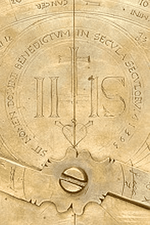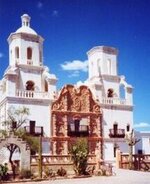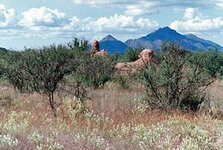sailaway
Hero Member
- Mar 2, 2014
- 623
- 815
- Primary Interest:
- All Treasure Hunting

Perhaps astrolabs were employed?
Made Several Compass Sundials
There is no description extant of Kino's compass but it is a matter of record that while in Cadiz he purchased a compass, probably a compass sundial, and that during the same period of waiting he made several compass sundials. In an entry in his diary, however, he referred to it as a mariner's compass. In addition to his map-making tools, which consisted of a compass, a telescope, and a mariner's astrolabe, Kino also was equipped with a copy of Adam Aigenler's Tabula Geographic-Horologa Universalis, to which were appended the tables of latitude and longitude from Book 9 of Tabula Geographiae et Hydrographia Reformata by Giovanni Battista Riccioli, published in Bologna in 1661. This work is specifically mentioned in Kino's diary.
Although magnetic variation was known before his time, there is no evidence that Kino made compensation for it, yet his observations and maps do not contain the errors that would occur if compensation had not been made for such variation. The assumption is that he probably made approximate corrections since he was dealing with a relatively small area, by comparing magnetic north (determined by means of his magnetic compass), with true north (determined by taking a sighting on Polaris). The difference observed was then applied to all magnetic bearings taken thereafter, providing a relatively valid true north anywhere in the area. Kino provided no description of his telescope except that it was portable, and that he had used it at sea. It was probably a refracting telescope made in the second half of the seventeenth century, and characteristically it was probably equipped with an objective not more than 2 inches or so, magnification not greatly in excess of 10, and a resolution of probably 3 seconds of arc. He may have mounted it on a tripod for field work.
All of the latitudes that Kino recorded were measured by means of the mariner's astrolabe. This instrument, standardized by 1550, consisted of a main plate with a loosely mounted suspension ring, an alidade attached to the plate at its center, and an erect sight at each end. The latitudes on Kino's maps were determined by the meridian altitude method, using Aigenler's Tables for declination corrections; his results suggest that his astrolabe may have had an index error of some 11 minutes of arc around the 60E point. Kino had few resources for determining longitude, and inasmuch as undoubtedly he had adequate mathematical and astronomical knowledge, it is likely that he may have attempted to use lunar eclipses for determining longitude.
deducer,
Can you give us a source for that information? One good source for post-Jesuit events in Mexico is: "Barbaros: Spaniards and their Savages in the Age of Enlightenment" by David Weber.
Thanks in advance,
Joe
When the Society was suppressed, the Pope gave the Jesuit possessions to the Franciscans. Many architectural changes were made to the missions to erase the Jesuit baroque style to a more simple Franciscan style.



When the Jesuits were expelled from California it was believed that they had discovered rich mines from which they derived immense wealth. The king, it was said, expected to amass four millions of dollars from the spoliation of the padres. Instead of four millions, however, less than one hundred was found in their coffers.
Interesting.. that link contains the following passage:
Are you then endorsing what is being said here?
deducer,
Not at all. On the other hand, they certainly did not find what they expected, nor what they were looking for.
Take care,
Joe
To realize more fully the extent of the Jesuit power in California, it is only necessary to add that the soldiers forming the mission guards were enlisted at the expense of the fathers. To be sure, the enlistment was in the king's name, and the soldiers were considered to be in the royal army, but as they were dependent upon the Jesuits for their pay and could be discharged by them for disobedience of orders and also were under command of an officer chosen by the fathers, it may be said that the little army in the peninsula was entirely controlled by the missionaries, who practically owned the barren country and its miserable natives.


This as well. Without getting into some of the other descriptions of how much the Jesuit missions had suffered from neglect during the interim, and how much may have been looted or misappropriated before the Franciscans arrived, it seems the Jesuits had expensive tastes.
"Junipero was not behind the visitador in tireless energy and work. He visited one mission after another to procure whatever could be spared to supply the needs of the new establishments. The list of the articles he took is an interesting one, showing, as it does, what was considered indispensable to the occupation and settlement of a new country. We find included in the long catalogue, seven large church bells, two heavy copper baptismal fonts, eleven pictures of the Virgin, and many images of Jesus, Joseph, and Mary. To these were added silver phials for sacred oil, silver censers and goblets and purificadores; innumerable brass candlesticks and nineteen complete sets of vestments. Junipero had a rich assortment of church properties to choose from. The expelled Jesuits had prided themselves on the costliness of their sacred vessels. All this church paraphernalia Junipero forwarded to La Paz, the sea-port from which the expedition was to start. It was as impossible in those days for Spain to fit out an expedition of conquests without friars, and a vast amount of church paraphernalia, as it would be nowadays to equip and send out an exploring fleet without a doctor and a well-stocked medicine chest."
Is this from Junipero Serra, the man and his work By Abigail Hetzel Fitch?